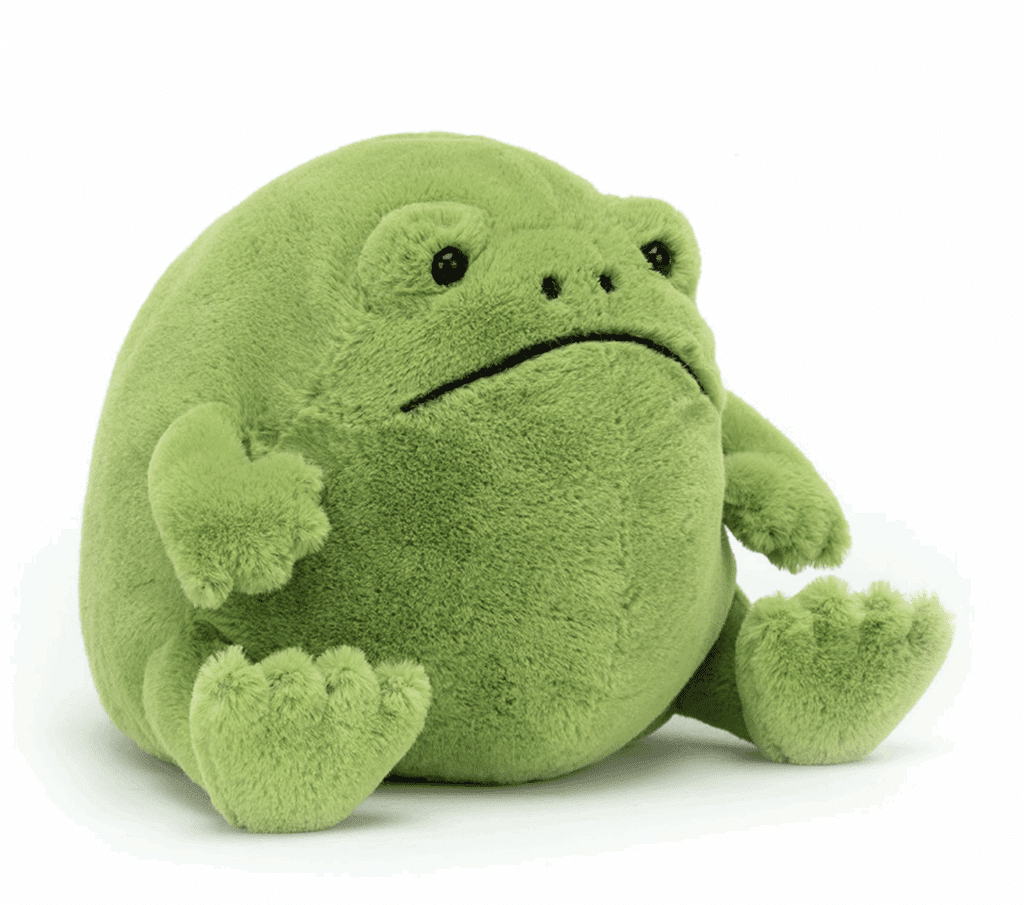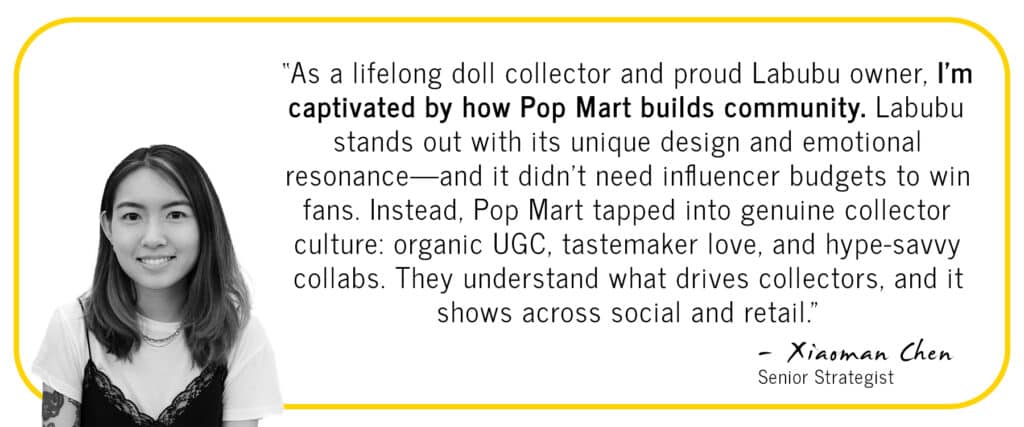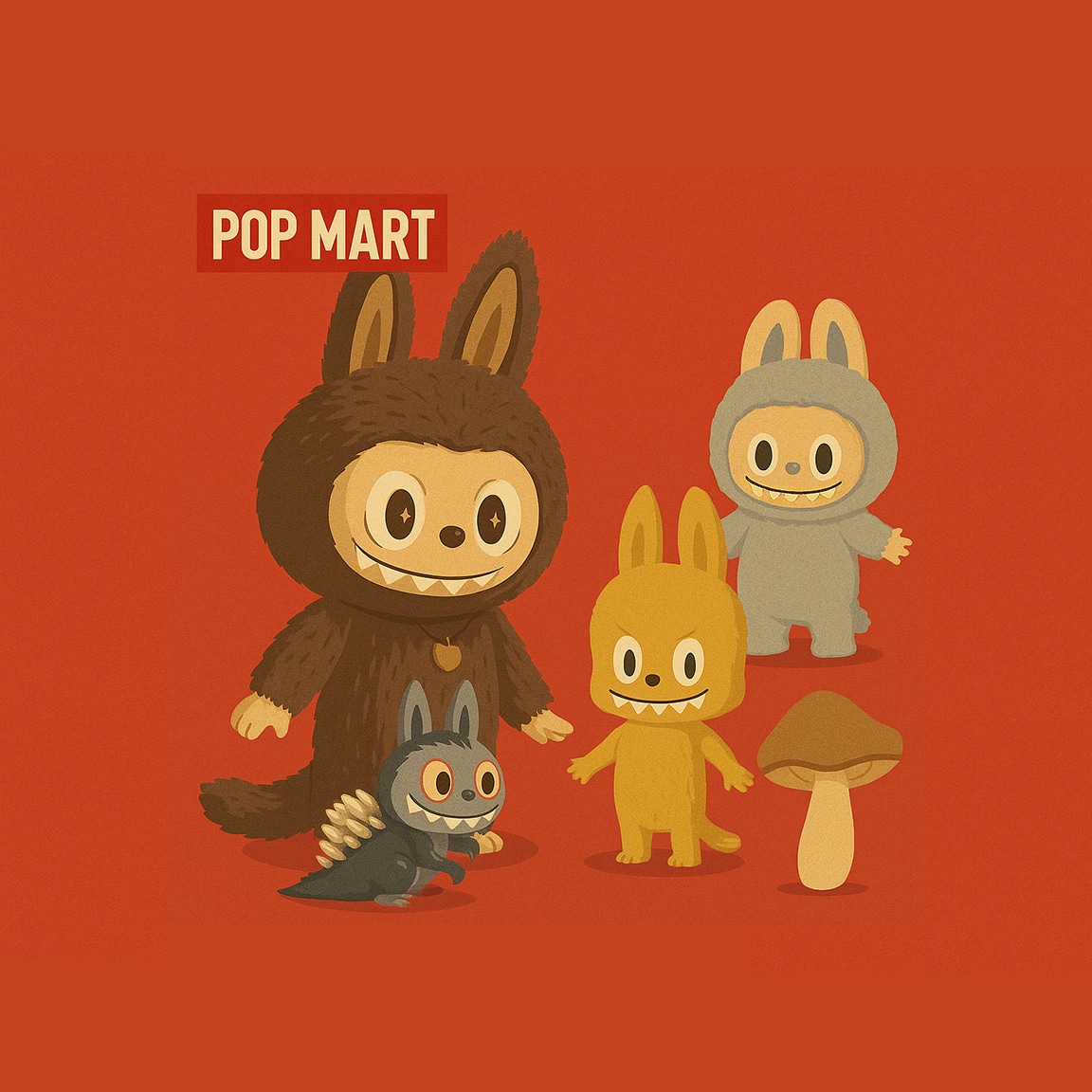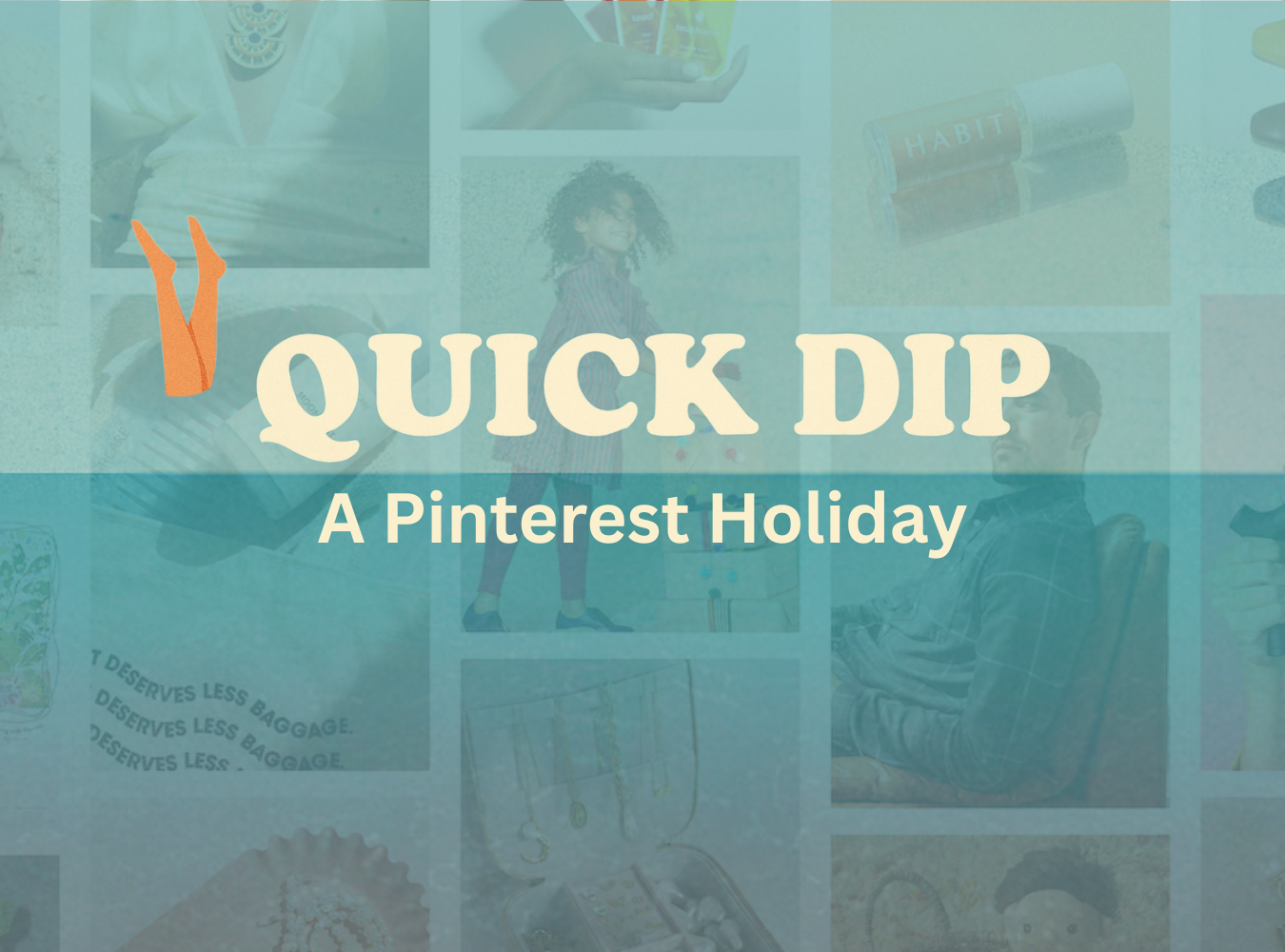Guest post by Xiaoman Chen, Senior Social Strategist at ListenFirst
How Pop Mart’s collectible character captured the internet’s heart through UGC, scarcity, and style-savvy storytelling
What happens when you mix fashion’s love for quirk, social media’s obsession with surprise, and a collector’s hunger for scarcity? You get Labubu — a small, wide-eyed creature, quickly becoming one of the most influential cultural exports out of China’s toy market. Born in 2015 from artist Kasing Lung’s imagination and propelled by Pop Mart’s sharp branding, Labubu is no longer just a blind-box collectible — it’s a viral symbol of community, creativity, and cross-cultural fandom.
What’s Happening?
From Blind Boxes to TikTok Stardom
Labubu, a jagged-toothed elf-like figure, debuted in 2015 and took off globally after Pop Mart began mass-producing it in 2019. Known for its “blind box” model, Pop Mart turned the doll into a viral phenomenon by tapping into randomness and exclusivity. The company now operates over 2,000 stores and vending machines worldwide (Pop Mart global retail footprint). It sells figures that have reached staggering resale values — a human-sized Labubu recently sold for $150,000 at auction (Labubu auction, June 2025).
The UGC wave that followed took Labubu from niche to mainstream. TikTok, Xiaohongshu, and Instagram exploded with unboxing videos, styling content, and custom mods. Fans crafted miniature wardrobes, furniture, and fantasy sets, turning the toy into a form of visual self-expression.
Viral Influencer Labubu unboxing video on TikTok
Pop Mart encouraged the creative loop by reposting user content, holding contests, and staging pop-ups like Comic Con appearances and dedicated exhibitions.
@mflores901 Happy early birthday to me! @Partiflair
♬ Labubu Labubu labu – tasan coelen
Example of video reposted by @popmart TikTok account
The fandom hit critical mass when BLACKPINK’s Lisa showcased Labubu, quickly followed by Kim Kardashian, Rihanna, Dua Lipa, Madonna, and Central Cee. This wave elevated Labubu from quirky collectible to a style accessory.

BLACKPINK’s member Lisa’s viral IG post featuring Labubu
Meanwhile, collaborations with Coca-Cola, e.l.f. Cosmetics, UNIQLO UT, Ravipa Jewelry, and One Piece brought Labubu further into global pop culture.
@popmartglobal Energy blast incoming! Hop on LABUBU’s spark and exlpore endless joy and inner power! 💥💫 #popmart #themonsters #labubu #bigintoenergy #kasinglung
♬ 原聲 – POP MART – POP MART
PopMarts top post of 2025 with 772.2K Engagements
Brand/Marketer Implications
Why Labubu’s Virality Offers a Blueprint for Collector-Focused Growth
Pop Mart’s Labubu strategy hits multiple modern marketing sweet spots:
- Surprise + Scarcity: The blind-box mechanic generates psychological urgency and repeat purchases, while limited runs trigger hype and resale activity.
- Creative-First UGC: Labubu fans are more than buyers — they’re stylists, creators, and storytellers. Pop Mart’s role is to elevate, not over-direct, this community energy.
- Global Retail Meets Digital Culture: Pop Mart’s expansion strategy is both physical and virtual. In the U.S., the company operates only about 40 stores compared to 400 in China — yet sales in the U.S. surged 5,000% year-over-year in June (M Science, 2025).
Despite criticisms around the blind-box model’s addictive nature — some liken it to gambling-style purchasing behavior — the model works. Pop Mart now boasts a $40B+ market cap, and its stock has jumped nearly 600% over the past year (Pop Mart stock valuation, 2025).
Labubu’s aftermarket economy mirrors sneakerhead culture: time-sensitive drops, instant sell-outs, and a booming resale scene where buyers flip exclusive figures at 10–100x markups. Bots and resellers camp in digital queues like it’s a Travis Scott Nike drop, turning Labubu into a new form of collectible streetwear capital.
For marketers, the lesson is clear: format can be as influential as function.

Platform or Cultural POV
Why Labubu Resonates Now
Labubu embodies what many younger consumers are drawn to today: aesthetic contradiction. With its jagged grin and wide eyes, it balances creepy and cute in a way that feels more emotionally honest than traditional character design. Rather than aim for polished perfection, Labubu leans into oddity—what some call “cute horror.” It aligns with the rise of offbeat style trends like coquette goth and creepycore, where the appeal lies in visuals that are slightly off, yet deeply personal.
This visual identity fits squarely into the online culture Labubu lives in. From 2023 to 2024, Pop Mart’s TikTok account saw engagement rise by 4,873%, and social conversation about Labubu jumped over 9,600% across platforms. These aren’t casual fans. Many are modders, stylists, and collectors who turn each figure into content, styling them with outfits, building miniature rooms, and treating each post as a performance.
Pop Mart has extended that immersion offline. In June 2025, the brand opened Popland, its first theme park, in Beijing. The park offers oversized installations, photo zones, and exclusive merch drops, designed to attract not just kids but teens, young adults, and online tastemakers. It’s a signal that Pop Mart doesn’t see Labubu as a toy brand—it sees it as a cultural franchise. Think more immersive concept store than kids’ attraction.
The Labubu phenomenon also invites comparison to the Beanie Baby craze of the late ’90s. Both tapped into scarcity, surprise, and community buzz. However, where Beanie Babies were traded through newsletters and eBay, Labubu lives in the algorithm. It spreads through TikTok edits, livestream unboxings, and resale group chats. Today’s collectors move faster, post more, and expect every purchase to carry both emotional and social value. It’s not just about owning something rare—it’s about showing, styling, and sharing it.
In contrast to mass-market collectibles like Funko Pop!, which rely on licensed IP and wide distribution, Labubu is more curated. While Funko offers breadth, Labubu offers distinction. The brand carefully controls its releases, focuses on original storytelling, and encourages customization. This makes it feel more like a designer toy than a mass-produced figurine. For Gen Z, that matters. It’s not just about fandom—it’s about taste.
The Comfort Toy Shift
Labubu’s popularity also fits into a much broader movement: the adult comfort toy market. This isn’t nostalgia; it’s self-soothing, self-styling, and sometimes even status signaling. Plush toys and stylized figures are now part of wellness culture, interior décor, and aesthetic identity. Global sales of soft toys reached $13.75 billion in 2025, with projections pushing it to $20.5 billion by 2030. In the UK, the category is valued at over £1 billion, driven heavily by adult buyers.
Jellycat, once a niche plush brand, has seen pieces resell for $500 or more. The brand brought in $252 million in 2023 alone. Sanrio’s characters like Hello Kitty and Kuromi have had a similar resurgence, fueled by kawaii aesthetics and the rise of character-based streetwear. Even Barbie entered the comfort toy space with plush tie-ins and lifestyle products following its blockbuster film. Funko, too, has leaned into cozy collectibles, with pastel figurines designed more for display than fandom.
What ties all of these brands together, and what Labubu captures so well, is a new kind of relationship between product and person. These aren’t just toys. They’re emotional objects. They make people feel something, look good on a shelf, and offer a way to connect with others who love the same strange little things.

Key Takeaways for Marketers
- Labubu’s rise is rooted in scarcity, community, and aesthetic distinctiveness, not conventional influencer playbooks.
- Blind-box formats drive repeat sales, but brands must be transparent and mindful of ethical concerns.
- Organic UGC is gold: fans don’t just show off Labubu—they style it, narrate it, and build worlds around it.
- Retail and resale can coexist: original dolls retail for ~$10, but top resales now hit six figures.
- Fashion + fandom = future brand power: Labubu is now a streetwear accessory, a social object, and a collector flex—all rolled into one.
- Livestream sales, if executed well, are no longer niche—they’re mainstream commerce channels.
Final Thought
Labubu may be small, but it represents a massive shift in how culture moves — from physical object to digital obsession to fashion accessory. It’s not just a toy; it’s a case study in emotional branding, fandom economics, and aesthetic fluency.
If you’re a brand trying to build the next Labubu, the question isn’t “What do we sell?”
It’s “What do we help people create, share, and obsess over?”
Pop Mart Social Snapshot – July 16, 2025
| Metric | Value | Change vs. Previous Period |
| Total Followers | 4.99M | +1% |
| Follower Growth | 33K | -43% |
| Fan Growth Rate | 0.66% | -44% |
| New Posts | 100 | +16% |
| Engagements | 438K | -54% |
| Response Rate | 0.42% | -60% |
| Video Views | 1.9M | +31% |
| Public Video Views | 1.48M | -51% |
Source: ListenFirst social analytics report (July 16, 2025)



